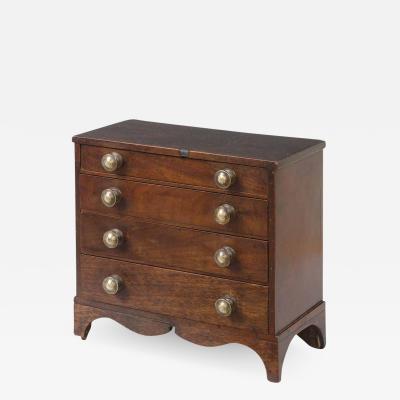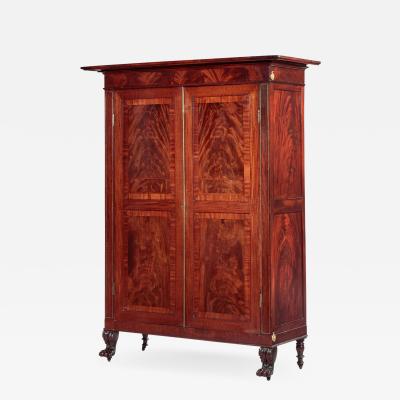Mini Furniture, Why?
Years ago when I inherited a miniature Victorian tester bed complete with original bedding, once belonging to my great grandmother, I wanted to know why she would have owned it?
Miniature furniture and the purposes of its use have fascinated collectors both in Europe and America. It is important to note the difference between various types of so called miniature furniture. Some furniture was made for use by children in the nursery, such as stools, tables and the still commonly found child’s chairs, approximately half size. Examples may be seen at the Bethnal Green Museum of Childhood, London.
Doll’s house furniture, approximately 1/10 to 1/12 (to full size), were not only play pieces, but larger examples were used to teach young ladies household management. For example, the Bethnal Green Museum has an 18th c. Nuremberg house model.
The collector of miniature furniture however, is usually interested in pieces of 1/8 scale, which may have been masterpieces, apprentice pieces, models, samples and show pieces.
In 18th c. France, young men were apprenticed to Masters who were members of guilds. Usually the apprentice learnt his trade for six years and made pieces under the Masters tutelage for a further three years. The French apprentice, contrary to popular belief, often made a full size piece of furniture for his examination sample. The piece was presented to a judge and six jurists, and was considered for the number of hours taken to produce the piece, the quality of the work, and the originality shown.
It appears that full size examples were more commonly made for examination in 18th century France, while in the 19th century, miniature examples were used. In either case, the piece was often signed by the apprentice. There is an outstanding collection of 18th and 19th century miniature furniture and objects in the Chateau de Vendeuvre, Calvados, France; included are such unusual pieces as a commode covered with embossed leather, a washbasin complete with cups and jugs, and a wonderful staircase.
In England, under the Statute of Artifices of 1563, a man could by law only become a master craftsman after serving an apprenticeship of seven years. It was stated that “Until a man grows into 23 years, he for the most part, although not always wild, is without judgement and not of sufficient experience to govern himself.”
The enforcement power of the corporations and guilds in England declined in the 18th century, and while there is little evidence existing of miniature furniture being made as master pieces, and even less of signed examples, it is certainly possible that pieces were made.
Miniature furniture of simple design and craftmanship is still found in England. For example, chests of drawers with no inlays, locks or escutcheons can be found. This may mean that some pieces of miniature furniture might be intermediary pieces showing a degree of skill and learning not only of town cabinetmakers, but of country craftsmen, too.
Surviving finer pieces of miniature furniture point to a craftsman showing skills as if for examination and approval. For example, a bureau can have complicated inlays on the fall, crossbanding between and on the drawers, working locks, gilt brass handles, and an interior revealing shaped drawers and cupboard, etc.
Figure 1 shows a Portuguese 18th c. miniature bureau. Another category of 18th century furniture was sent to China and India to be copied full scale for Europeans living there, and more importantly to be exported to Europe. Often these full size and miniature pieces were decorated with exotic inlays, as shown in figure 2, an East India Vizagapatam miniature 18th c. bureau in ivory. More frequently Chinese and Indian export furniture was copied from drawings, hence the unusual proportions and details often found.
In England miniature furniture was used as advertisments in shop windows of furniture makers and retailers. A potential purchaser could examine the piece and discuss extra cost details, such as further inlays or choice of woods such as oak, walnut or mahogany. Equally important was the travelling retailer going to the small town or country house where the customer or patron could be shown a miniature example, the viewing of a three dimensional example being more effective than only sketches or drawings.
Figure 3 shows a miniature working spinning wheel which could be taken apart and packed up for carriage travel.
Further 18th and 19th century miniature pieces were made for particular purposes. For example, miniature pianos opened to reveal a work box interior, or miniature chest of drawers were used as cosmetic cabinets.
I am unable to explain why relatively large numbers of surviving categories of miniature furniture such as bureaus, chests of drawers and tables exist, while there is a scarcity of chairs, tallboys, corner cupboards and bookcases for example.
Whatever the reasons for the existence of miniature furniture may be, they do have great appeal in just being tiny versions of a full sized piece. There is something thrilling about opening the doors of a cupboard and finding sliding trays, or letting down the fall of a bureau and discovering a perfect interior with pigeonholes and tiny drawers. And then wondering if an apprentice boy made it for practice and perhaps gave it to his sweetheart? Did a child play with it, as a very special toy? Or is the attention to scale and detail so perfect as to make it a sample to tempt customers to order a full size one? Perhaps it is the mystery unsolved that holds the key to the attraction of miniature furniture. Andrew Jenkins is a specialist in 17th-Mid-19th Century English furniture, clocks and barometers, metalwork and treen. His shop, Avon Antiques, est. 1963, is located at 25 Market Street, Bradford-on-Avon, Wiltshire BA5 1LL, England. Telephone from the U.S.: 011.44.122.586.2052. Avon Antiques will be exhibiting at the Grosvenor House Art & Antiques Fair, London, June 14-20.
Bibliography:
Le Chateau de Vendeuvre, Mobilier Miniature Edward Gelles, Nursery Furniture Edward Pinto, Treen & Other Wooden Bygones Jane Toller, Antique Miniature Furniture in Great Britain & America Herbert Schiffer, Miniature Antique Furniture Georgio & Luca Gracis, catalogue of Miniature English Furniture















.jpg)
.jpg)
.jpg)
















